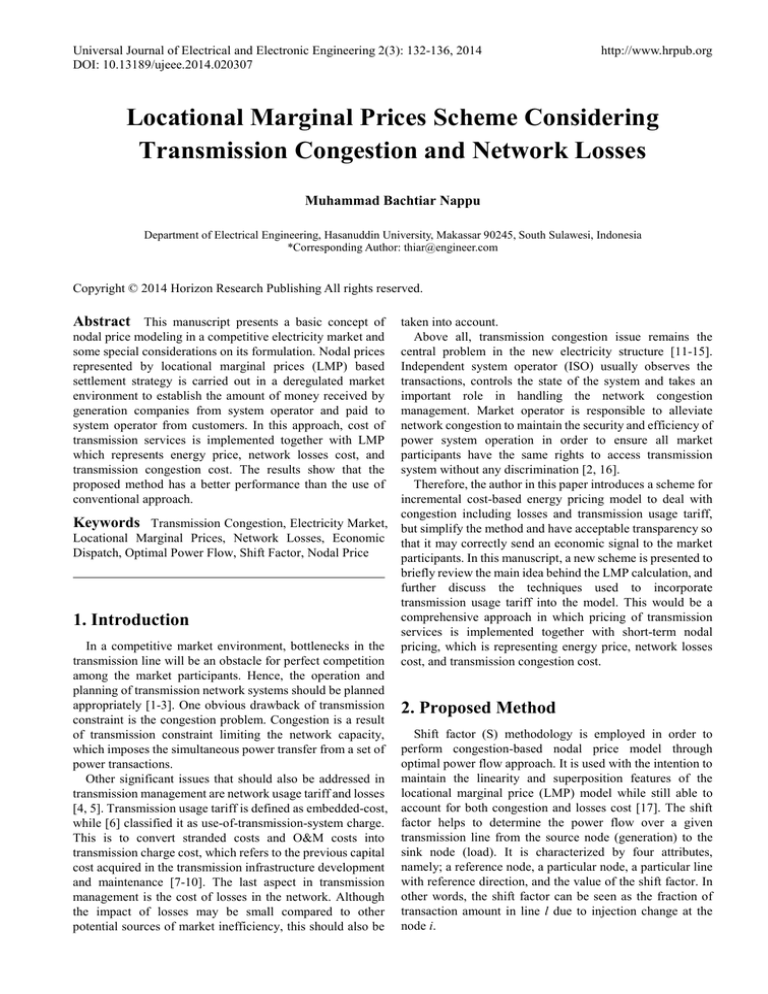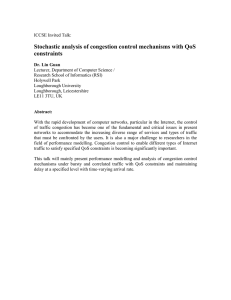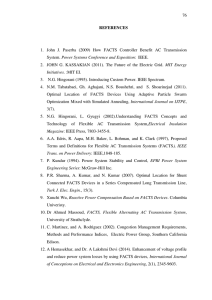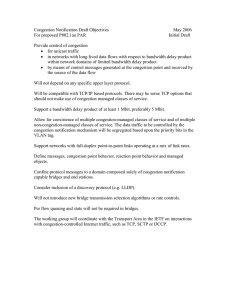
Universal Journal of Electrical and Electronic Engineering 2(3): 132-136, 2014
DOI: 10.13189/ujeee.2014.020307
http://www.hrpub.org
Locational Marginal Prices Scheme Considering
Transmission Congestion and Network Losses
Muhammad Bachtiar Nappu
Department of Electrical Engineering, Hasanuddin University, Makassar 90245, South Sulawesi, Indonesia
*Corresponding Author: thiar@engineer.com
Copyright © 2014 Horizon Research Publishing All rights reserved.
Abstract This manuscript presents a basic concept of
nodal price modeling in a competitive electricity market and
some special considerations on its formulation. Nodal prices
represented by locational marginal prices (LMP) based
settlement strategy is carried out in a deregulated market
environment to establish the amount of money received by
generation companies from system operator and paid to
system operator from customers. In this approach, cost of
transmission services is implemented together with LMP
which represents energy price, network losses cost, and
transmission congestion cost. The results show that the
proposed method has a better performance than the use of
conventional approach.
Keywords Transmission Congestion, Electricity Market,
Locational Marginal Prices, Network Losses, Economic
Dispatch, Optimal Power Flow, Shift Factor, Nodal Price
1. Introduction
In a competitive market environment, bottlenecks in the
transmission line will be an obstacle for perfect competition
among the market participants. Hence, the operation and
planning of transmission network systems should be planned
appropriately [1-3]. One obvious drawback of transmission
constraint is the congestion problem. Congestion is a result
of transmission constraint limiting the network capacity,
which imposes the simultaneous power transfer from a set of
power transactions.
Other significant issues that should also be addressed in
transmission management are network usage tariff and losses
[4, 5]. Transmission usage tariff is defined as embedded-cost,
while [6] classified it as use-of-transmission-system charge.
This is to convert stranded costs and O&M costs into
transmission charge cost, which refers to the previous capital
cost acquired in the transmission infrastructure development
and maintenance [7-10]. The last aspect in transmission
management is the cost of losses in the network. Although
the impact of losses may be small compared to other
potential sources of market inefficiency, this should also be
taken into account.
Above all, transmission congestion issue remains the
central problem in the new electricity structure [11-15].
Independent system operator (ISO) usually observes the
transactions, controls the state of the system and takes an
important role in handling the network congestion
management. Market operator is responsible to alleviate
network congestion to maintain the security and efficiency of
power system operation in order to ensure all market
participants have the same rights to access transmission
system without any discrimination [2, 16].
Therefore, the author in this paper introduces a scheme for
incremental cost-based energy pricing model to deal with
congestion including losses and transmission usage tariff,
but simplify the method and have acceptable transparency so
that it may correctly send an economic signal to the market
participants. In this manuscript, a new scheme is presented to
briefly review the main idea behind the LMP calculation, and
further discuss the techniques used to incorporate
transmission usage tariff into the model. This would be a
comprehensive approach in which pricing of transmission
services is implemented together with short-term nodal
pricing, which is representing energy price, network losses
cost, and transmission congestion cost.
2. Proposed Method
Shift factor (S) methodology is employed in order to
perform congestion-based nodal price model through
optimal power flow approach. It is used with the intention to
maintain the linearity and superposition features of the
locational marginal price (LMP) model while still able to
account for both congestion and losses cost [17]. The shift
factor helps to determine the power flow over a given
transmission line from the source node (generation) to the
sink node (load). It is characterized by four attributes,
namely; a reference node, a particular node, a particular line
with reference direction, and the value of the shift factor. In
other words, the shift factor can be seen as the fraction of
transaction amount in line l due to injection change at the
node i.
Universal Journal of Electrical and Electronic Engineering 2(3): 132-136, 2014
S =
∆ flow in line l
∆ injection at node i
Shift factor values will depend on network topology and
line impedance. Once these two variables change, the value
of shift factor will change as well.
Meanwhile dispatch model discussed in this paper
encompasses energy price, transmission congestion revenue,
and transmission losses cost. Embedded cost in terms of
transmission usage tariff is also added into this formulation.
Market operators use different approaches to account this
tariff, such as: postage-stamp method, contract path method,
MW-mile method, or counter-flow method [18].
So far, pricing for transmission services using such
methods above are still separately accounted from energy
market price calculation. With the intention of having an
efficient, transparent, and effective pricing due to
transmission network usage services, LMP models under this
scheme will be formulated by taking into account the tariff
for transmission usage as well.
By incorporating this component, the scheme is expected
to simplify the method and to have acceptable transparency
so that this may send economic signal correctly to the market
participants [19-21]. Accordingly, formulation for this
model will be as follow;
Total transmission usage tariff is written as
Tm ( PGi ) = α m . flowm
(1)
The objective function is to minimize the total social cost
and transmission usage tariff to decide the power supply and
required demand.
nG
M
∑α
Min
flow ( P ) + ∑ [ ai PG2i + bi PGi + ci ]
m
m
Gi
=
m 1 =i 1
−
nD
∑ [d
i =1
i
(2)
PD2i + ei PDi + fi ]
Subject to the following constraints
∑P
i
− Ploss ( PGi ) =
Gi
∑P
(3)
Dj
j
PGi min ≤PGi ≤ PGi max
PDj min ≤PD j ≤ PD j max
In order to obtain optimum solution for the calculation of
congestion cost and locational marginal prices, the first order
of Karush-Kuhn-Tucker (KKT) optimal condition should be
reached, which is derived from the Lagrange function.
If we assume
Gloss = 2 .[ S ]T .[ R ]. [ S ]
where
[AG] = [MG]T.[Gloss].[MG]
[BG] = [MD]T.[Gloss].[MG] = [MG]T[Gloss][MD]
[CG] = [MD]T.[Gloss].[MD]
After obtaining the first order of Karush-Kuhn-Tucker
optimal condition, marginal nodal prices or LMPs for both
supplier and consumer nodes may be formulated as follows:
∑ PGi − ∑ PDj + ∑ µ min, flow, m . S m, n
j∈ J ( i ' )
m
i∈ I ( i ' )
(7)
flowm ( PGi )
− ∑ µmax, flow, m . S m, n − ∑ α m .
. Sm, n
flowm ( PGi )
m
m
I
ρi = λ 1− ∑ Gloss
i ' =1
) ∑T
M
m
m
nG
nD
i =1
i =1
The merchandizing surplus (MS) which contains
congestion revenue, cost of losses, and transmission usage
tariff will be:
MS = λ . Ploss ( PGi ) + ∑ µ max, flow, m . flowm − ∑ µ min, flow, m . flowm
m
m
(8)
+ ∑ α m . flowm ( PGi )
m
3. Results and Analysis
The proposed method is implemented with a simple 3-bus
system. Some important characteristics are evaluated to
describe beneficial features of the proposed method. The
system is required to deliver an aggregated load of 800 MW.
System details consisting of generation and branch profile
are given in Table I. Further implementation of the proposed
method on an IEEE reliability test system (IEEE-RTS) as
well as on different issues can be found at [22-31].
mi
($/MW2h)
min Gi
(MW)
max Gi
(MW)
G1
20
0.015
150
600
G2
18
0.015
50
400
Branch Profile
(
) + ∑ µ (P
(P − P ) + ∑ µ (P
( flow − flow ) + ∑ µ
− ∑ µ min, D , j PD j − PD j
min
− ∑ µ min,G , I
min
i
− ∑ µ min, flow,m
m
Generator Profile
bi
($/MWh)
( PGi ) + ∑ Ci ( PGi ) − ∑ Bi ( PDi )
+ λi ∑ PD j − ∑ PGi − Ploss ( PGi )
j
i
I
n,n'
Table 1. 3-Bus System Generator and Branch Details
With referring to the objective function and the constraints,
Lagrange function is then formed using Lagrangian
multipliers. These multipliers are referred to dual prices or
shadow prices.
(
GI
GI
m
i
I
m
max, D , j
Dj
− PD j
max
max,G , I
GI
− PGI
max
min
m
(5)
T
1 [ PGi ]1xi [ AG ]ixi [ PGi ] ix1 −
(6)
Ploss ( PGi ) = .
T
2 2. PDj [ BG ] PDj jx1 + [ BG ]
ixi
ixi
1xi
flowmmin ≤flowm≤flowm max
L PDi , PGi , λi , µ i =
133
max, flow , m
)
)
( flow
(4)
m
− flowm
max
)
n'
n’'
r
p.u.
x
p.u.
cap
(MW)
αm
($/MWh)
L1
1
2
0.0134
0.1335
200
2
L2
1
3
0.0067
0.0665
550
1
L3
2
3
0.0084
0.1002
350
1.25
134
Locational Marginal Prices Scheme Considering Transmission Congestion and Network Losses
From the simulation, it can be observed that the minimum
cost is achieved when node-2 is selected as the reference
node. This option makes an optimal power supply for
network losses at 24.00 MW, compared to 24.06 MW and
25.53 MW for node-1 and node-3, respectively.
Although node-1 and node-2 tend to have the same
network losses supply, selecting node-2 as reference node
gives a minimum objective value as well. This is similar to
the results of model without adding the embedded cost.
However, LMPs obtained under this scheme are now having
additional cost; namely transmission usage tariff. As a result,
despite all generators’ output and total branch losses being
similar before and after incorporating the embedded cost, the
objective value, cost of losses, and merchandizing surplus
are different. The relationship between objective value and
merchandizing surplus relatively to the selection of reference
node are given in Figures 1 and 2.
It is obvious from simulation results that the most
significant finding is that branch flow over transmission line
2-3 becomes un-congested when node-2 is selected as the
reference node. Meanwhile choosing node-1 or node-3 as
reference node or even for all reference nodes under scheme
without losses component, line 2-3 is always in binding
circumstances. This means transmission congestion is able to
be avoided which is in this case by choosing node-2 as the
reference node.
3500
SF-OPF
congestion revenue takes a big portion in performing
merchandizing surplus. Illustration about the change of
branch flow is shown in Figures 3-7.
In summary, based on all output parameters resulted from
the simulations, it is clearly proven that the proposed method
shows an improved performance compared to the widely
well-known conventional method, DC-OPF.
Findings of this work are supposed to be useful to support
developing standard market design in transmission networks,
which promotes economic efficiency, lowers delivered
energy costs, maintains power system reliability and
mitigates exercising market power.
G1
425.62 MW
G2
400 MW
26.990 $/MWh
26.832 $/MWh
L1
39.23 MW
L2
360.77 MW
464.85 MW
L3
28.707 $/MWh
800 MW
Figure 3. Unconstrained Branch Flow
MDC-OPF
G2
388.54 MW
G1
435.52 MW
3000
$/h
2500
2000
26.533 $/MWh
1500
25.038 $/MWh
L1
38.54 MW
1000
congested
500
L2
0
1
2
Reference Node
350 MW
450 MW
28.741 $/MWh
Figure 1. Merchandizing Surplus
19320
19300
19280
L3
3
SF-OPF
MDC-OPF
800 MW
Figure 4. Constrained Branch Flow Using SF-OPF with Ref. Node #1
$/h
19260
19240
19220
19200
19180
19160
19140
19120
19100
G1
424 MW
G2
400 MW
25.150 $/MWh
1
2
Re fe re nce Node
3
Figure 2. Objective Value
Accordingly, there is no congestion revenue, and
merchandizing surplus only contains cost of network losses,
which is the lowest cost of losses as well for this scheme.
That is why merchandizing surplus and objective value in
this option are about half of the value of other selected
reference node, as shown in Figures 1-2. Normally, this
25.056 $/MWh
L1
31.57 MW
L2
344.42 MW
455.58 MW
L3
No
Congestion
26.622 $/MWh
800 MW
Figure 5. Constrained Branch Flow Using SF-OPF with Ref. Node #2
Universal Journal of Electrical and Electronic Engineering 2(3): 132-136, 2014
G2
375.82 MW
G1
449.71 MW
27.352 $/MWh
REFERENCES
[1]
W. W. Hogan, "Independent System Operator: Pricing and
Flexibility in A Competitive Electricity Market," John F.
Kennedy School of Government, Harvard University,
Cambridge, Massachusetts Feb. 1998.
[2]
R. D. Tabors and S. Adamson, "Price Discrimination in
Organized/Centralized Electric Power Markets," 2006.
[3]
G. B. Shrestha and P. A. J. Fonseka, "Congestion-driven
transmission expansion in competitive power markets," IEEE
Transactions on Power Systems, vol. 19, pp. 1658-1665,
2004.
[4]
R. D. Christie, B. F. Wollenberg, and I. Wangensteen,
"Transmission management in the deregulated environment,"
Proceedings of the IEEE, vol. 88, pp. 170-195, 2000.
[5]
J. B. Cardell, "Improved Marginal Loss Calculations during
Hours of Transmission Congestion," 2005.
[6]
A. K. David, "Dispatch methodologies for open access
transmission systems," IEEE Transactions on Power Systems,
vol. 13, pp. 46-53, 1998.
[7]
P. Kaymaz, J. Valenzuela, and C. S. Park, "Transmission
Congestion and Competition on Power Generation
Expansion," IEEE Transactions on Power Systems, vol. 22,
pp. 156-163, 2007.
[8]
M. C. Falvo, "An approach for transmission system
expansion planning in electricity market," 2006
[9]
H. Rudnick, R. Palma, and J. E. Fernandez, "Marginal pricing
and supplement cost allocation in transmission open access,"
IEEE Transactions on Power Systems, vol. 10, pp. 1125-1132,
1995.
25.453 $/MWh
L1
25.82 MW
congested
L2
350 MW
475.53 MW
L3
30.113 $/MWh
800 MW
Figure 6. Constrained Branch Flow Using SF-OPF with Ref. Node #3
G2
387.64 MW
G1
436.88 MW
26.553 $/MWh
23.815 $/MWh
L1
32.47 MW
congested
L2
350 MW
462.19 MW
L3
29.529 $/MWh
800 MW
Figure 7. Constrained Branch Flow Using DC-OPF
4. Conclusions
There are three significant issues of transmission
management that should be properly handled to accomplish
open access environment in a competitive electricity market,
such as: transmission congestion cost, network losses cost as
well as transmission usage tariff. Besides, an effective
congestion-based nodal price modeling is the key factor in
determining transmission pricing, which could generate
economic signal especially as congestion happens.
A comprehensive tool for congestion-based nodal pricing
is need to be developed to encourage transparent and
competitive price but still be able to address the issues
surrounding transmission management.
Therefore, in this paper a new perspective of the impact of
market clearing mechanisms on electricity pricing is
addressed. An alternative method that makes use of shift
factor based optimal power flow is developed as an
improvement over traditional DC optimal power flow
method. The results show that the proposed method has a
better performance than the use of conventional approach.
135
[10] I. J. Perez-Arrilaga, F. J. Rubio, J. F. Puerto, J. Arceluz, and J.
Marin, "Marginal pricing of transmission services: an
analysis of cost recovery," IEEE Transactions on Power
Systems, vol. 10, pp. 546-553, 1995.
[11] H. Singh, S. Hao, and A. Papalexopoulos, "Transmission
congestion management in competitive electricity markets,"
IEEE Transactions on Power Systems, vol. 13, pp. 672-680,
1998.
[12] R. S. Fang and A. K. David, "Transmission congestion
management in an electricity market," IEEE Transactions on
Power Systems, vol. 14, pp. 877-883, 1999.
[13] F. C. Schweppe, M. C. Caramanis, R. D. Tabors, and R. E.
Bohn, Spot Pricing of Electricity. Boston: Kluwer Academic
Publishers, 1988.
[14] T. W. Gedra, "On transmission congestion and pricing," IEEE
Transactions on Power Systems, vol. 14, pp. 241-248, 1999.
[15] J. Cardell, "A Real Time Price Signal for FACTS Devices to
Reduce Transmission Congestion," 2007.
[16] D. Shirmohammadi, B. Wollenberg, A. Vojdani, P. Sandrin,
M. Pereira, F. Rahimi, T. Schneider, and B. Stott,
"Transmission dispatch and congestion management in the
emerging energy market structures," IEEE Transactions on
Power Systems, vol. 13, pp. 1466-1474, 1998.
[17] California-ISO, "Shift Factors: Methodology and Example,"
in CAISO Market Operations: [online] Available:, 2008, pp.
136
Locational Marginal Prices Scheme Considering Transmission Congestion and Network Losses
http://www.caiso.com/docs/2004/02/13/2004021316094386
84.pdf.
[18] M. Shahidehpour, H. Yamin, and Z. Li, Market Operations in
Electric Power Systems. New York: John Wiley & Sons, Inc.,
2002.
[19] E. D. Farmer, B. J. Cory, and B. L. P. P. Perera, "Optimal
pricing of transmission and distribution services in electricity
supply," IEE Proceedings-Generation, Transmission and
Distribution, vol. 142, pp. 1-8, 1995.
[20] G. Hamoud and I. Bradley, "Assessment of transmission
congestion cost and locational marginal pricing in a
competitive electricity market," IEEE Transactions on Power
Systems, vol. 19, pp. 769-775, 2004.
[21] P. A. J. Fonseka and G. B. Shrestha, "A Study on the Pricing
of Network Services," presented at International Conference
on Power System Technology, PowerCon, 2006.
[22] M.B. Nappu, T.K. Saha, P.A.J. Fonseka, “Assessment of the
Effectiveness of Different Pricing Schemes for Transmission
Congestion Management”, in The 84th National Electric
Energy Society of Australia (EESA) Conference and
Exhibition, Brisbane, Australia, 2008.
[23] M. B. Nappu, T. K. Saha, and P. A. J. Fonseka, "Investigation
on congestion-based optimal energy price for competitive
electricity market," in IEEE International Conference on
Sustainable Energy Technologies, Singapore, 24-27
November, 2008, pp. 860-865.
[24] M. B. Nappu and T. K. Saha, "A comprehensive tool for
congestion-based nodal price modelling," in IEEE Power &
Energy Society General Meeting (PES-GM), Calgary,
Alberta, Canada, 26-30 July, 2009, pp. 1-8.
[25] M. B. Nappu, T. K. Saha, and A. Arief, "Analysis of the
influence of transmission congestion on power market based
on LMP-lossless model," in 19th Australasian Universities
Power Engineering Conference, AUPEC '09, Adelaide,
Australia, 2009, pp. 1-6.
[26] M. B. Nappu and T. K. Saha, "Study on Congested Power
System in Competitive Electricity Market: A Proposed
Methodology," in International Power Engineering
Conference, IPEC '10, Singapore, 27-30 October, 2010, pp.
830-835.
[27] M. B. Nappu and T. K. Saha, "Financial withheld-based
market power within congested power system," in 21st
Australasian Universities Power Engineering Conference,
AUPEC '11, Brisbane, Australia, 2011, pp. 1-6.
[28] M. B. Nappu, A. Arief, T. K. Saha, and R. C. Bansal,
"Investigation of LMP forecasting for congested power
systems," in 22nd Australasian Universities Power
Engineering Conference, AUPEC '12, Denpasar, Bali,
Indonesia, 2012, pp. 1-6.
[29] M. B. Nappu, R. C. Bansal, and T. K. Saha, "Market power
implication on congested power system: A case study of
financial withheld strategy," International Journal of
Electrical Power & Energy Systems, Elsevier, vol. 47, pp.
408-415, 2013.





